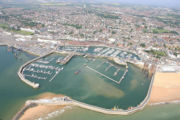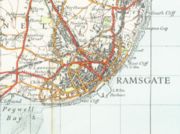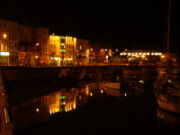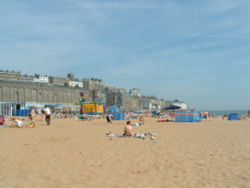Ramsgate
2007 Schools Wikipedia Selection. Related subjects: Geography of Great Britain
| Ramsgate | ||
|---|---|---|
|
|
||
| Statistics | ||
| Population: | 37,967 | |
| Ordnance Survey | ||
| OS grid reference: | TR385645 | |
| Administration | ||
| District: | Thanet | |
| Shire county: | Kent | |
| Region: | South East England | |
| Constituent country: | England | |
| Sovereign state: | United Kingdom | |
| Other | ||
| Ceremonial county: | Kent | |
| Historic county: | Kent | |
| Services | ||
| Police force: | Kent Police | |
| Fire and rescue: | {{{Fire}}} | |
| Ambulance: | South East Coast | |
| Post office and telephone | ||
| Post town: | RAMSGATE | |
| Postal district: | CT11 | |
| Dialling code: | 01843 | |
| Politics | ||
| UK Parliament: | Thanet South | |
| European Parliament: | South East England | |
Ramsgate is an English seaside town on the Isle of Thanet in East Kent. It was one of the great English seaside towns of the 19th century and is a member of the ancient confederation of Cinque ports. Population: 2001 census 37,967.
Ramsgate's main attraction is its coastline and its main industries are tourism and fishing. The town has one of the largest marinas on the English south coast and Port Ramsgate has provided cross channel ferries for many years.
History
Ramsgate as a name has its earliest reference as Hraefn's ate, or cliff gap, later to be rendered 'Ramisgate' or 'Remmesgate' around 1225 and 'Ramesgate' from 1357.
Ramsgate's Royal Harbour
The construction of Ramsgate Harbour was begun in 1749 but not finally completed until about 1850.
The two most influential architects of the Harbour were John Shaw Senior and John Shaw Junior. They designed the clockhouse, the obelisk, the lighthouse and the Jacobs Ladder steps . It has the unique distinction of being the only Royal Harbour in the United Kingdom, King George IV having awarded the title following his successful visit with the Royal Yacht Squadron in 1821.
It is evident from many accounts of local sea rescues that the Ramsgate tugboats, whilst undertaking salvage work were also able to assist with the saving of lives. The Tugmen performed many a noteworthy task in this regard, either alone or by co-operation with the Lifeboats, which they would regularly tow to the scene of an imminent disaster to stand off whilst the smaller craft would attend.
A Lifeboat station was established at Ramsgate as early as 1802, its first Lifeboat having been built for the Trustees of the Harbour by the lifeboat pioneer Henry Greathead. Half a century later however, during which time the station had been closed for 28 years, a new Ramsgate Lifeboat, the 'Northumberland' appeared there in 1851. The lifeboat was named in honour of the lifeboat sponsor, the Duke of Northumberland. The new and prized boat had been built in accordance with the plans of a model that had been the prize-winner in the 1851 national competition for the best design for such a craft.
It was in the summer of 1824 that Captain K. Martin, then the Harbour Master at Ramsgate, instituted the proceedings of the first known cricket match on the Goodwin Sands, at low water. Such was the tenacity of local mariners, a tradition sprung up that survives to this day, whereby those so inclined make the journey to the Sands for a leisurely few hours in pursuit of this very English past-time.
In 1859 Jerimiah Walker (having previously distinguished himself by his humane, zealous and successful efforts in rescuing the Master and the crew of the Northern Belle), as a seaman of the lugger "Petrel" assisted in the rescue of the crew of the Spanish vessel "Julia", which had become stranded off Ramsgate. For this assistance he was awarded a medal struck on the Authority of Queen Donna Isabella II of Spain, thus Walker is believed to be one of the few men to have received two separate medals issued by different Heads of State.
On New Year's Day 1861 an event at sea of considerable loss of life occurred with the wreck of the " Guttenburg". Then, as now, without a doubt, by far the most hazardous area around the Kent coastline to any navigator was the most notorious Goodwin Sands.
Electric Tramways & Lighting Co. Ltd.
At the turn of the 20th century, the Isle of Thanet saw the introduction of about 11 miles of track, laid down for the use of the Electric Tramways & Lighting Co. Ltd, which began its service with electric trams on 4 April 1901, linking the towns of Ramsgate, Margate and Broadstairs. On 3 August 1905, an unseasonably wet summer's day, Car No. 41, during a routine descent of the precipitous, and adverse camber leading down Madeira Walk hill into Ramsgate harbour, suddenly careered out of control, jumping the tracks, causing it to crash straight through the railings, so that it then dropped over the 30-foot cliff edge adjacent. Providentially, only a few passengers were travelling on Car No. 41 that day, and they came out of the ordeal unscathed, but the driver, who was new to the job, sustained some injury. The Electric Tramways & Lighting Co. Ltd. continued to operate with no further significant incidents recorded until its services were replaced with the buses of the East Kent Road Car Co, which began on 27 March 1937.
This was one of the few inter-urban tramways in Britain, owned by a private company and running through open countyside between the three towns (most of it built over now}. Much of the route was on its own right of way, and this only became public roads when the tramway was abandoned.
The line started in Westbrook west of Margate, at the junction of Canterbury and Walton roads. A little tram-shed survived there until recently, and the tram-tracks were to be preserved in the housing development replacing it. Along Canterbury Road and the sea-front, then dividing in two. In the Broadstairs direction, up Paradise Street (now incorporated into Fort Hill dual carriageway); from Broadstairs, down Fort Hill and along King Street. Then Fort Crescent, Athelstan Road, Northdown Road to private track connecting to Lower Northdown Road. This bit is now a public footpath. Lower Northdown Road eastwards to the Wheatsheaf, then cuts across country to Northdown Hill. This bit is a rough track now. Past the main tramshed on the corner, still there and used as factory units, into Westover Road. Church Street (over railway) to St Peters, Albion Road to crossroads, left under railway bridge by Broadstairs station, along Broadstairs High Street to Queens Road, Oscott Road and the seafront. Then along private right of way to Ramsgate, now Dumpton Park Drive. Bellevue Road, Plains of Waterloo, Nelson Crescent, down Madeira Walk to Ramsgate Harbour. Up Royal Parade, Paragon, St Augustines Road, all the way along Grange Road, right at Park Road, to the old South Eastern Ry station where it had its own approach to the south of the station.This was the terminus.
There was also a short-cut between Ramsgate and St Peters called the Top Road, which ran from the crossroads by Broadstairs station, south along Osborne Road, Gladstone Road, across Ramsgate Road and on private right of way (now Salisbury Avenue) to the main line. This was very lightly used and no-one is sure why it was built. Broadstairs town wanted to build a proper town centre at the station crossroads before WWI but could not find the money, and this may have had something to do with it.
The company wanted to extend to Birchington, but was defeated by the landowners of housing estates at Westgate who wanted to keep the riff-raff away. Perhaps as a result, Westgate was refused its application to become a separate urban district because it lacked "civic character" before WWI (it became part of Margate).A line to Pegwell village was also proposed.
The trams were double-decker, but never had roofs on the upper deck, even in winter. This was because the track was narrow-gauge and there were many right-angle bends. Twelve could squeeze into the lower deck, where there were two wooden benches facing each other, but in bad weather the top deck was extremely unpleasant. The service could not hope to compete with buses all year round, even if the trams were fondly remembered on hot summer days.
Ramsgate at war
Because of its proximity to mainland Europe, Ramsgate was a chief embarkation point both for the Dunkirk evacuation and during the Napoleonic Wars. 4,200 ships left Ramsgate Harbour to rescue men from the Dunkirk beaches during World War 2.
On 24 May 1990, the 50th anniversary of the evacuation of Dunkirk was remembered when some 80 of the original 'little ships' gathered at Dover and Ramsgate to repeat the now historic crossing of the channel. Only six out of this fleet had any difficulties, but were assisted by others in the flotilla.
One of these little ships was the first Motor lifeboat stationed of Ramsgate which was named the 'Prudential' and had arrived on station by 1926. During World War II the Ramsgate lifeboat and crew were called out 60 times, greatly distinguishing themselves with the saving of 170 lives, in addition to the men brought back from Dunkirk: (Jeff Morris).
One of the Dunkirk 'little ships' still moored at Ramsgate and open to the public is the Motor Yacht Sundowner, (built 1912) once the private yacht of the second officer of the Titanic, C.H. Lightoller, whom surviving that fatal wreck later insisted personally at being at the helm during the evacuation of Dunkirk. He succeeded in bringing home 127 members of the 'Expeditionary Forces' in just one trip.
After these events 42,783 soldiers were transported from Ramsgate railway station, carried by 82 southern rail special trains, the second busiest station during the evacuation, next to Dover, which carried over 180,000 men moved by 327 trains.
Shortly before the outbreak of World War II the local council, thanks in large part to the town Mayor Alderman Kempe , decided to enlarge the existing tunnels under the town as a public air-raid shelter - and after the war started the national government finally gave permission to spend the money - it was built and used a lot during the raids. See the Subterranea Britannica website for mote details.
Geography
Ramsgate is located 78 miles from central London in an East South Easterly direction at one of the most Easterly points of the country (the furthest point east being North Foreland in nearby Broadstairs). Infact, Ramsgate even has its own meridian line and Mean Time which is 5 mins 41 secs ahead of Greenwich Mean Time.
The town is now the amalgamation of two settlements. One being the fishing community based on the coast in the shallow valley between two chalk cliffs and the other a farming community inland that is now the Parish of St. Lawrence. The cliffs are now known as the East Cliff and the West Cliff and are predominantly residential areas. There are promenades along both cliff tops with parks at either end and sand beaches on the coast.
Politics
Ramsgate falls in the Thanet South constituency, a seat won by Labour Member of Parliament Dr Stephen Ladyman. The seat was won after digraced Conservative MP for Thanet South, Jonathan Aitken, was convicted of perjury and sentenced to 18 months in prison.
The town is currently an unparished area, and does not have a town council, but a movement called 'Ramsgate First' is campaigning to form one.
Political History
Something almost amounting to a tradition for industrial militancy may be found in the history pages of Ramsgate. Such an occasion happened in August 1920 when following a decision by the Ramsgate corporation to sell 1000 tons of locally produced coke to Denmark, set of what became known as the 'coke riot'. It was unfortunate perhaps that these shipments were to be transported by two German ships, the first world war still fresh in local minds. Massive police protection of the harbour was required, but this did not prevent local people from venting their displeasure upon the local authorities.
During the 1984 National Union of Mineworkers Strike, Ramsgate became the focus of media attention with several blockades of the Harbour by the coalmen of the nearby colleries, which had until then supported a sizable workforce throughout Thanet.
Ramsgate was also the original location of the pressure group Critical Mass, which began its days in opposition to the government of Margaret Thatcher, often in support of the NUM. Critical Mass was founded in 1984 as a result of regulations that prevented local inhabitants out of work from living in the then-numerous empty hotels desperate for trade. The BBC made a documentary about these events, which was named Red Herrings, and broadcast on BBC2 in 1985.
Economy
Ramsgate's main industries are tourism and fishing. The town has a thriving marina with over 800 moorings and a range of marine-related businesses that operate in premises in the renovated arches under Royal Parade. The town caters extensively for students of EFL (English as a foreign language) at its colleges.
Port Ramsgate has provided cross channel ferries for many years. Previously Sally Ferries provided a service of passenger and car ferries to Dunkirk. Currently a service of prodominantly freight is provided to Oostende.
There is some light industry in the town. A possible future industry is power generation, with a potential 800 jobs being created by the projected London Array, a wind farm just off the coast.
Demographics
- Population: 1989 census estimate 38,200.
- Population: 2001 census 37,967
Culture
Tourism
Ramsgate's main attraction is its coastline, particularly Ramsgate Main Sands, which has been awarded a 2006 Blue Flag, assuring high standards of cleanliness and general beach management.
There is an annual Powerboat Grand Prix event based out of the harbour of Ramsgate during the summer.
Sports
Ramsgate Football Club plays its home games at The Southwood Stadium (capacity: 5,000) and wears an all red outfit at home and yellow and green away from home. Ramsgate had previously been called Ramsgate Athletic and it is not since these days that Ramsgate had qualified for the First Round Proper of the FA Cup, until the 2005/06 season. Ramsgate played in the Isthmian League (formerly Ryman League) Division One during the 2005/06 season, after gaining promotion from the Kent League and went on to win the league (joint on points with Horsham). They have therefore been promoted to the Isthmian League Premier Division for the 2006/07 season.
Notable Residents
- Gary Pallister, a Footballer who played for Manchester United F.C. and Middlesbrough F.C. was born in Ramsgate.
- During a period of increased religious emotion, Vincent Van Gogh taught french amongst other things as a supply teacher at a school at 6 Royal Road and boarded at 11 Spencer Square for a period in 1876. He made some sketches of the view from his lodgings overlooking the harbour. The proprietor of the school relocated to Isleworth, Middlesex. Vincent decided to walk to the new location, which took 3 days via Canterbury and Chatham. This new position did not work out, and Vincent became a nearby Methodist minister's assistant in wanting to "preach the gospel everywhere".
- Karl Marx is known to have stayed in the town around 9 times, as did his commrade Friedrich Engels. One known spot is on Hardres Street.
- Whilst still a princess, Queen Victoria spent holidays in Ramsgate and stayed at Townley House, near what is now Farleys Furniture Store.
- Former British Prime Minister Edward Heath was schooled at Chatham House Grammar School.
- Comedian Frank Muir was born in Ramsgate and also schooled at Chatham House.
- Olympic gold medalist for hockey, Sean Kerly, was another attendee of Chatham House.
- Architect, Moses Montefiore was heavily involved in the affairs of Ramsgate and owned East Cliff Lodge. His tomb is adjacent to the synagogue in Ramsgate.
- Mathematician Alfred North Whitehead was born in Ramsgate
Architecture
The town has three notable churches. The first building used for worship in the Thanet parish of 'St Lawrence' was at St Laurence-in-Thanet, built in 1062 and rebuilt during the following centuries with the most significant changes being in the 16th century. Note the difference in spelling between that of the Village of St Lawrence and the church, which is dedicated to the Roman Martyr, Laurence.
The second notable church is St Augustines, which is situated on the towns westcliff. Considered one of the most august and distinct surviving St Augustine's, it was designed by Augustus Pugin in 1847 in the neo-Gothic style. Its dedication commemorates Augustine, the first Archbishop of Canterbury, who landed at Ramsgate in AD 596 and brought Christianity to Britain.
Thirdly, the town's Parish Church of St George is situated just off the towns highstreet and provides a striking view over the town and a trip to view its lantern tower is well worth a visit. The ground was concecrated on 23 October 1827. Its latern tower was added at the request of Trinity House as a navigational aid to passing ships
St Augustine' serves its own abbey and the town's Catholic community, whilst St Laurence and St George are both Church of England, and serve the anglican community as part of the Diocese of Canterbury.
Ramsgate library was original built and paid for by Andrew Carnegie in 1904. On the evening of Friday 13th August 2004 a fire destroyed Ramsgate library just two months short of its 100th anniversary. Though suspicions were raised as to what started the fire due to a similarily timed fire at the towns registry office, an inquest concluded that the blaze was too intense to pinpoint where and how the fire started. Plans for a new library are now in place and it is hoped a new one will be built by 2007.
Transportation
By Sea
The harbour provides shelter from the effect of storms and is close to the Goodwin Sands. It is now the site of one of the largest and most thriving marinas on the English south coast (there were 12,000 visiting boats in 2005) with 800 moorings.
The town has had a long and chequered relationship with cross channel ferries. Passenger ferries to Dunkirk were operated for many years by Sally Ferries who eventually were forced to close due to stiff competition from Dover-Calais ferries and the Channel Tunnel. Trans Europa Ferries passenger and freight ferries now frequently sail to Ostend in Belgium.
By Road
The main route to Ramsgate from London is to follow the M2 motorway to its bitter end and to get onto the A299. At St Nicolas-At-Wade roundabout take the 3rd exit onto the A299 (signposted Ramsgate). At Monkton Roundabout take the 2nd exit onto the A253 (signposted Ramsgate, Broadstairs). At Minster Roundabout take the 2nd exit onto the A253 (signposted Ramsgate, Broadstairs). Continue forward onto Canterbury Road West - A253. At Lord Of The Manor roundabout (a double roundabout) take the 2nd exit and then the first exit onto Canterbury Road East - A299 (signposted Ramsgate).
By Rail
Ramsgate railway station is operated by Southeastern (train operating company) and is situated at the top of the town near the parish of St Lawrence.
Trains from the station run to London Charing Cross and London Victoria via Margate, Chatham and Bromley South, or via Canterbury West or Dover Priory and Ashford International.
By Air
The town is situated directly under the flight path of Kent International Airport at Manston. From September 2004 to August 2005 a low-cost airline EUjet operated frequent flights to many European destinations, replacing a large freight operator. However, flights were suspended after the collapse of its parent company, PlaneStation Group plc.
The sale of Manston to Infratil (owner of Glasgow Prestwick International Airport) was completed on 26 August 2005. Charter operator Kent Escapes will use the Manston site to run weekly passenger flights to Barcelona, Spain and Faro, Portugal from summer 2006. Infratil are in negotiations with other airlines to add further destinations.
Education
Infant Schools
- Dame Janet Infant School
- Ellington Infants School
- Newington Infants School
- Priory Infants School
Junior Schools
- Christ Church C Of E Junior School
- Dame Janet Junior School
- St Ethelbert's R C Junior Mixed & Infants School
- Newington Junior School
- St Laurence C Of E Junior School
Primary Schools
- Newlands County Primary School
- Chilton County Primary School
Secondary Schools
- Chatham House Grammar School
- Clarendon House Grammar School
- Ellington High School
- St Lawrence College
Colleges and further education
- Ramsgate's nearest college is Thanet College. This is situated in the nearby town of Broadstairs. There is also a new campus for Canterbury Christ Church University which is situated in Broadstairs which is within very easy reach of Ramsgate.
Affiliations
'Twin cities/towns






